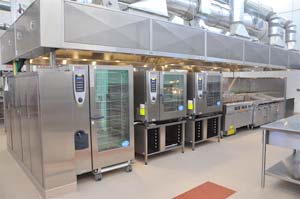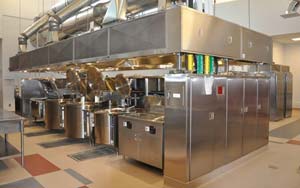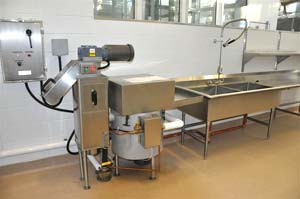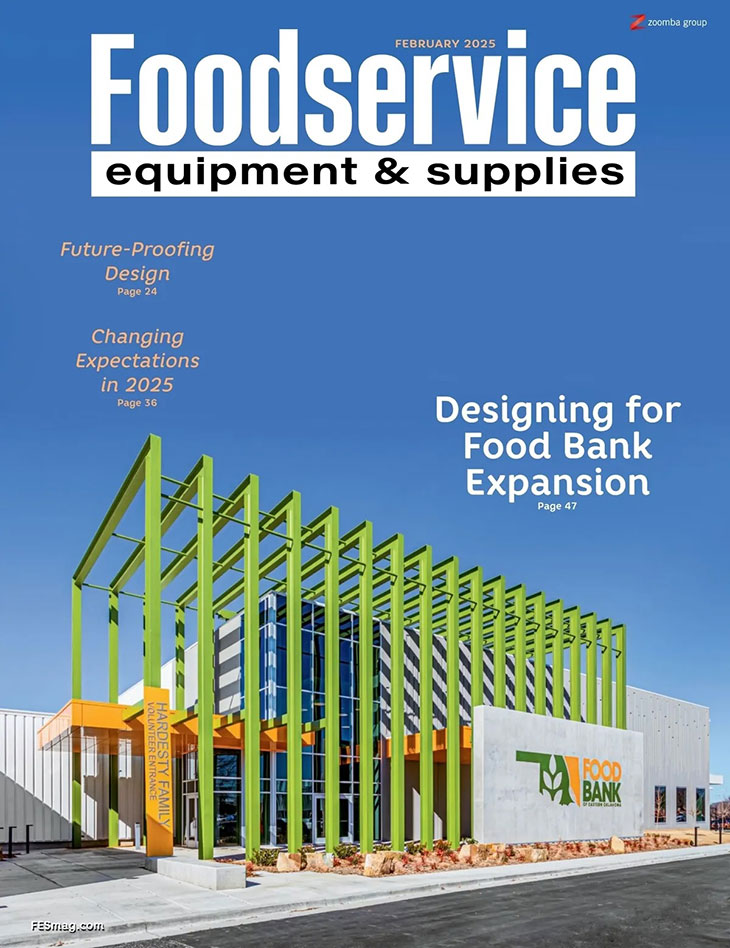Learn how a Canadian foodservice project leveraged a variety of energy-saving and waste-reducing technologies to earn LEED status.
To help its members kick off The NAFEM Show, FCSI hosted a well-attended half-day seminar that centered on a common theme: embracing technology. While presenters touched on LEED, food safety, labor and efficient design, the tying bind between these topics was the idea that digital, wireless and software-based technologies maybe not so new to the world, but certainly newer to the foodservice industry, can enhance all four of these aspects of food production and hospitality.
Doug Feltmate, president of Designed Food Systems Inc. (DFS) in Ottawa, Ontario, shared details of his Canadian government-funded project, which earned LEED Gold designation last month, just two points shy of the highest level, Platinum. The six-year project, an Ottawa-based, 22,000 square-foot food production facility for the 4,500 Parliamentary Precinct of Canada workers, offers a clear outline of some of these enhanced design elements and digital technologies that aren't necessarily new, but are being embraced by increasing numbers of designers and operators to improve efficiencies in all aspects of kitchen performance. These technologies address a variety of issues ranging from speed of service to labor to energy- and water-savings to food safety and equipment maintenance monitoring and can benefit all foodservice operations regardless of whether they are pursuing LEED status.
Automated Food Safety and Equipment Maintenance
 Designed using the practices and work flows as outlined in the Canadian Food Inspection Agency (CFIA) guidelines, the kitchen was built in zones to ensure that products at different stages of the production cycle (i.e. prepared food versus raw food) do not come into contact. In addition, all prep work on raw produce and proteins (sourced from within a 100-Kilometer range) takes place in separate cold rooms, each with their own walk-in cooler. This processing cycle also maintains separated waste streams.
Designed using the practices and work flows as outlined in the Canadian Food Inspection Agency (CFIA) guidelines, the kitchen was built in zones to ensure that products at different stages of the production cycle (i.e. prepared food versus raw food) do not come into contact. In addition, all prep work on raw produce and proteins (sourced from within a 100-Kilometer range) takes place in separate cold rooms, each with their own walk-in cooler. This processing cycle also maintains separated waste streams.
More importantly, a fully integrated HACCP/NAFEM Data Protocol monitoring system was incorporated to assist with product quality control and equipment maintenance with the intent of driving optimal performance. To do this, DFS worked directly with equipment manufacturers and software developers to create a comprehensive program that monitors the food from receiving to storage to processing and final delivery to the end user on the precinct.
Coolers are continuously monitored to ensure optimal storage temperatures are met. In the event that temperatures drop below acceptable parameters, an alarm is triggered so foodservice management can respond appropriately. In addition, kettles, tilting skillets, sheet pans and other batch-cooking equipment are retrofitted with probes that monitor food temperatures every 20 seconds, from the start of the cooking process through blast chilling and truck transport from the central commissary to other points of service. The system also monitors temperatures of food coming into the facilities at the dock.
"No one ever has to touch the product to take temperatures," Feltmate says. Better yet, workers take the temperatures using a hand-held scanner, and the information goes directly to the central software management system for access using both computers and smart phones.
"We need to move away from the days of the pen and paper for HAACP monitoring," said Roberta Salerno of Integrated Control Corp. in Huntington, N.Y. Salerno made her comments during FCSI's pre-NAFEM conference.
There is too much room for human error and too much potential for major food safety mistakes to occur. Feltmate drove this idea home by adding that in so many kitchens he would find that on the HACCP – temperature monitoring checklists on the side of equipment, someone had scribbled the exact same temperature, hour after hour, day after day.
Going digital when it comes to food safety also helps operators maintain daily, weekly, monthly and yearly records that document their efforts over the long haul and some of these more automated programs may require less staff time and training, making the business even more efficient.
 In addition to temperature and HACCP management, the software for the Parliamentary Precinct project is NAFEM Data Protocol Compliant, meaning it allows the operator to incorporate equipment maintenance schedules and related reminders. As such, the program synchs multiple manufacturer monitoring programs through one system, allowing staff to monitor all the equipment in the kitchen at one time, from both computers and smart phones. This includes alarms for coolers and freezers if temperatures dropped too low, and other notifying elements such as equipment use, to let operators know when they may need to perform service maintenance on the equipment or replace units.
In addition to temperature and HACCP management, the software for the Parliamentary Precinct project is NAFEM Data Protocol Compliant, meaning it allows the operator to incorporate equipment maintenance schedules and related reminders. As such, the program synchs multiple manufacturer monitoring programs through one system, allowing staff to monitor all the equipment in the kitchen at one time, from both computers and smart phones. This includes alarms for coolers and freezers if temperatures dropped too low, and other notifying elements such as equipment use, to let operators know when they may need to perform service maintenance on the equipment or replace units.
The program also standardizes recipes and the accompanying food safety protocol. A complete operations manual including HACCP-based Standard Operating Procedures for use in the operation provided the client with a guideline for the day to day operations.
"Food safety is definitely going to be even more of a priority in the next two to three years," Feltmate believes. "I think these systems will eventually be mandatory – it's going that way in Canada."
Food Waste Reduction
Working in tandem with a local and seasonal food sourcing program, blast chillers help increase the shelf life of seasonal, locally-sourced ingredients and prevent waste because these products, if not used fresh immediately, can be packaged and stored for future use. Using pressurized skillets, induction burners and combi ovens to prepare food rather than traditional open-flame ranges and ovens help reduce cooking times and therefore, energy and exhaust requirements.
In addition, sousvide technology cooks whole cuts of meat to desired doneness from edge to edge and prevents product shrinkage. Sous-vide products can also be more easily blast chilled and stored for later use because of their packaging.
As part of the operation, the complete waste management component includes a pulper, composting of organic waste, an outdoor herb garden on the green roof and a program for recycling of products to ensure nothing is wasted.
Energy-Efficient Equipment
Throughout the kitchen design process consideration was given to environmentally friendly applications. This included a variable controlled, on-demand kitchen exhaust system, water-saving dishwashers, enclosed and insulated cooking equipment, and purchasing Energy Star-rated appliances where applicable. And, the project's exhaust system uses outside air during the colder five months of the year to pre-cool all cold prep areas, as well as a geothermal heating system for the whole building.
Natural Lighting Enhancements
 In addition to incorporating new technologies to minimize energy and water consumption, this project also includes unique building design elements that ensure every working area incorporates natural lighting. "Kitchens are often dark caves," says Feltmate. "With this project, we wanted to ensure that employees in all areas had an opportunity to work in natural light. Besides the obvious energy savings this provides, the working conditions are naturally improved. Regardless of equipment selection, layout or design, good food still requires good staff. Providing them with a pleasant work environment is critical to employee satisfaction and has a direct correlation on output."
In addition to incorporating new technologies to minimize energy and water consumption, this project also includes unique building design elements that ensure every working area incorporates natural lighting. "Kitchens are often dark caves," says Feltmate. "With this project, we wanted to ensure that employees in all areas had an opportunity to work in natural light. Besides the obvious energy savings this provides, the working conditions are naturally improved. Regardless of equipment selection, layout or design, good food still requires good staff. Providing them with a pleasant work environment is critical to employee satisfaction and has a direct correlation on output."
To accomplish this, the building was designed with windows in the top third of the structure, allowing natural daylight to flood the production floor. Internal work areas featured cooler panels with 6 foot windows to allow the natural light to penetrate all areas of the production environment, including the walk-in coolers and freezers as well as the production areas.
"We were able to work directly with the manufacturers to design the cold area panels with windows built into the top half of the panel," Feltmate says. "This allows the light to flood naturally into each work area, providing employees with a bright, airy work environment."
The trend toward technology will only become stronger, in Feltmate's opinion. "Definitely as more people use iPhones, iPads and other smart phones and tablets, we will see more applications being used for various things." From buying books to searching for restaurants to scanning menus and digital ordering, to HAACP monitoring, equipment maintenance, staff monitoring and other smart kitchen aspects. Stay tuned.




